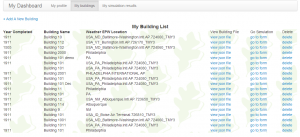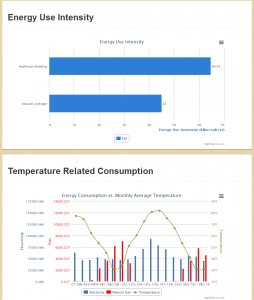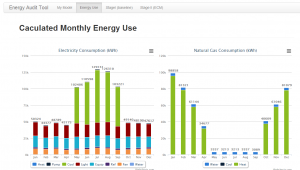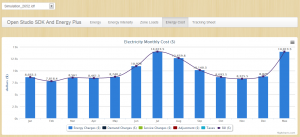Note: The Simulation Platform was a product of the CBEI Simulation & Modeling Team, a collaboration of research universities, national labs, and private sector industry, headed by Dr. Jelena Srebric, Professor of Mechanical Engineering at the University of Maryland.
In order to compare building energy performance before and after a building energy retrofit, there are several variables that must be accounted for, including changes in building occupancy, change in weather, equipment changes, and changes in building control settings. This type of analysis is typically in the realm of highly skilled building science experts and requires a surfeit of time.

Simulation Platform-Home Page
CBEI created the Simulation Platform to circumvent much of the need for a technical background when undertaking basic building energy simulations so a relative layperson can begin to tinker with building energy design, while also simplifying more involved simulations to reduce input and processing time for professionals. The Simulation Platform’s modeling application dramatically lightens the load for a user through a simple interface and quick outputs.

The Simulation Platform is simply a suite of web simulation tools, which process models on the “cloud” (i.e. on a remote server), given a set of user inputs. The platform is organized around four different interfaces – Lite, Partial, Substantial, and Comprehensive – listed in an increasing order of model complexity. This means that as a user moves from Lite to Comprehensive, the platform demands an increasing amount of detail about building characteristics, but also yields an increasingly accurate simulation. Each interface can be used independently, but when signed in, the data can be automatically ported from one level to another, allowing smooth information transfer between project team members. Models can also be saved in the cloud, continued throughout the life of a project, and reviewed by any team member with the login.
The platform is built upon the integrated systems approach to decision-making that is central to CBEI’s mission. The interconnected aspect of tools in the platform should democratize the access to energy modeling tools and also improve communication among different stakeholders in their efforts to optimize the overall building performance.
Lite, or “Benchmark” 

The Lite interface of the platform is formulated for building owners, who might not know detailed information about building construction and composition. Building owners can input utility data, building location and type, and the Simulation Platform will output graphs and regression models depicting energy use intensity for heating and cooling. In the coming months, the Lite output will also be able to advise the user on typical energy conservation measures (ECM) by climate zone and building type that are within budget range (this feature is in development). The Lite energy outputs and recommended ECMs are lower-accuracy estimations, because many assumptions about the building must be made in order to simplify the model. In other words, the Lite interface bases its output on a “typical” building, but misses much of the nuanced detail that makes your specific building operate differently.
There are two underlying simulation engines used in the Lite interface. The ASHRAE Inverse Modeling Toolkit calculates regression models in order to take reliable and accurate measurements of energy and demand savings from energy efficiency retrofits [1]. Second, the IBM Inverse Modeling Engine benchmarks and triages the best candidates among a large portfolio of buildings based on utility information [2]. The buildings identified can then be exported to the higher level tools described next.
Partial, or “Systems Benchmark” 
 The Partial interface is geared towards building designers, and is powered by MIT’s Design Advisor Tool, developed with support from CBEI. The Design Advisor Tool targets both non-technical and technical designers, enabling them to evaluate building energy performance of different retrofit design strategies quickly. In this interface, energy use intensity is imported from the Lite model output to provide context for the information the project designer will add. While most simulations use HVAC data estimations, users will also be able to add actual manufacturer HVAC system data to the model, thanks to Carnegie Mellon’s HVAC Module [3].The simulated output provides information about heating, cooling and lighting energy usage. Based on the input information, the team can also learn how to optimize daylight distribution within the room and air temperature from natural ventilation. It can also advise the project team about occupant comfort based on mechanical settings, building structure, window manipulation and natural impacts on the building (local weather, daylight, external temperature, etc.).
The Partial interface is geared towards building designers, and is powered by MIT’s Design Advisor Tool, developed with support from CBEI. The Design Advisor Tool targets both non-technical and technical designers, enabling them to evaluate building energy performance of different retrofit design strategies quickly. In this interface, energy use intensity is imported from the Lite model output to provide context for the information the project designer will add. While most simulations use HVAC data estimations, users will also be able to add actual manufacturer HVAC system data to the model, thanks to Carnegie Mellon’s HVAC Module [3].The simulated output provides information about heating, cooling and lighting energy usage. Based on the input information, the team can also learn how to optimize daylight distribution within the room and air temperature from natural ventilation. It can also advise the project team about occupant comfort based on mechanical settings, building structure, window manipulation and natural impacts on the building (local weather, daylight, external temperature, etc.).
The Partial model output provides a list of recommended ECMs, such as structural retrofits to roof and wall insulation, glass window coating options and multiple thermal mass options, which are more specific to the building. The tool also advises the user on building control retrofits such as heating and cooling set points, light fixture dimming, and ventilation rates. The user will be able to manipulate the simulation results based on these predetermined measures and watch the results change, reflecting potential savings based on hypothetical measures taken.
Substantial, or “Subsystems Audit” 

The Substantial interface is designed for the building auditor, and takes into account primary HVAC schedules (including fuel types) and weekly occupancy habits. This interface requests information about the building’s shape, materials, subsystems, and schedules that must be gathered through a building audit. The Substantial interface also receives information from the Partial interface about promising systems to fix, based on available data on the breakdown of energy use by system and noted irregularities compared to similar buildings.
Three tools power this interface. First, the Energy Auditing Tool facilitates walkthroughs and data collection throughout the building commissioning process, powered by United Technologies Research Center (UTRC) DeepRetro Engine [4]. When using the Auditing Tool on an iPad, collected data can automatically populate the Substantial interface’s form.
Second, to facilitate reduced risk, Uncertainty Quantification is applied to building energy analysis, while sensitivity analysis identifies key parameters that affect output [5]. The uncertainty quantification is applied to key parameters and can determine the lowest risk retrofit measures: what could save the most energy and what measures are statistically confident to actually save energy.
Third, the University of Pennsylvania’s Parametric Analysis Toolkit is designed to evaluate the impact of system control parameters on energy consumption for potential optimization [6]. With this tool the designer can select certain model inputs to manipulate either the total gas or total electricity consumed by HVAC systems.
Comprehensive, or “Retrofit Staging” 

The Comprehensive model requires the most knowledge of building characteristics and operation. The interface is designed for building analysts who can import a 3D model of the building, as well as information about a typical room on each façade of the building, the air tightness level, the lighting systems and schedules, and a range of mechanical specifications. The goal of this model is to target retrofits of small and medium buildings that do not have a budget for highly detailed analysis or consultants. This is a sizeable market area that has been neglected, until now.
This interface uses the Retrofit Manager Tool (RMT) which enables facility managers to quickly review whether a building could improve its performance via retrofit by providing reduce order energy simulations for facility managers, which require minimal inputs, but yield a higher level of accuracy than the simplified models in the other interfaces. RMT uses the information entered in the Comprehensive interface to construct a baseline energy model from which to select and analyze energy efficiency measures. RMT currently has a list of nineteen energy efficiency measures in five categories: HVAC, Enclosure, Lighting, Plug Load, and Occupancy/Schedule. The building analyst will be able to apply these measures to the Comprehensive output results and see which ones yield the highest energy and budget savings.
RMT is distinct, because it allows for retrofit staging, in which recommendations are actually weighed based upon their impact when interactions are considered. For example, an auditor may provide a top 5 list of retrofit measures, but after the first four measures are installed, the fifth measure may not necessarily be the next best measure to install. RMT accounts for the effects of staged interventions and recommends further measures based on these collective impacts [7],
Several open source tools power RMT. CBEI is the first to make these building simulation tools usable online for the public.
- EnergyPlus (E+) is a stand-alone building energy simulation program that models heating, cooling, ventilation, lighting, water, and other energy flows in buildings. E+ lacks a user friendly graphical interface, but instead operates by reading and writing text files. E+ is a DOE tool that came out of the merger of two predecessors, DOE-2 & Blast.
- OpenStudio is the software development toolkit upon which the simulation platform is built. It allows the simulation data from the Comprehensive model to be output in .idf, .osm, and other types of industry-standard files so that experienced energy auditors, engineers, and facility managers can utilize the full functionality of the other underlying tools.
- DAYSIM conducts daylighting calculations, including a photo sensor component for energy efficiency optimization. EEB Hub funded enhancements to the existing DAYSIM tool allowing it to function alone, and in the context of RMT. RMT can create a simulation of what a façade would look like, then include weather data from EPWeather and ouput an hourly blind or shade operation schedule. It will also help RMT determine an annual zone lighting strategy for energy savings.
- CONTAM is a physics-based model that computes contaminant transport in order to conduct the airflow modeling for the building. Unintentional airflow is categorized as zone-to-zone leakage, or unwanted airflow from outside of the building to inside the building (otherwise known as infiltration). Infiltration can contribute up to 25% of a building’s heating and cooling load and is therefore a prime area for potential savings. CONTAM uses a general-purpose multi-zone airflow contamination code as the baseline. It then translates the energy model of the building into an airflow model, and uses that to compute infiltration. EEB Hub funded the integration of CONTAM with OpenStudio. RMT improves the OpenStudio model by running CONTAM before EnergyPlus.
Looking Forward
By March of 2014, Simulation Platform will be able to pre-populate the interface input fields with more types of buildings – strip mall retail, hospitals, schools, etc. The Simulation Platform team also plans to have more variables available for occupancy schedules and different schedule types, which might greatly impact the energy savings results for lighting and HVAC operation.
Other development efforts include enabling users to import building data already submitted through EPA Portfolio Manager (required by benchmarking ordinances throughout the United States) and the display of cost savings estimates.
Future simulation platform development is decided based on user inputted suggestions which are voted upon at http://tools.eebhub.org/ideas. Prospective users are encouraged to vote or add ideas of their own.
References
[1] Kissock, J. K.; Haberl, J. S.; Claridge, D. E. Development of a Toolkit for Calculating Linear, Change-Point Linear and Multiple-Linear Inverse Building Energy Analysis Models, ASHRAE Research Project 1050-RP, Final Report. http://repository.tamu.edu/handle/1969.1/2847
(The product was made web-accessible by EEB HUB Developers Nick Mattise and Payam Delgoshaei)
[2] Young M. Lee, Rui Zhang, Steve Estepan Meliksetian. IBM Inverse Modeling Engine. Analytics for Smarter Buildings. http://domino.research.ibm.com/library/cyberdig.nsf/papers/7A83DFDC8478F8D285257BA200550772/$File/rc25393.pdf
[3] Chong, A. (CMU), Mandelbaum, A. (MIT), Wang, H. (CMU), Lam K. P. (CMU), Glicksman, L. (MIT). Massachusetts Institute of Technology. Development prototype of HVAC Module for MIT Design Advisor Web Application. http://developer.eebhub.org/cmu/
[4] Stella Oggianu, Russ Taylor, Marija Trcka. Decision Support Tool for Deep Energy Efficiency Retrofit in DoD Installations. United Technologies Research Center (UTRC). http://estcp.org/Program-Areas/Energy-and-Water/Energy/Conservation-and-Efficiency/EW-201257/EW-201257/. The product was made web-accessible by Ying Sun (HUB), Dennis Ding (UTRC), Payam Delgoshaei (HUB), Matias Seibert (PSU), Josh Wentz, (HUB). The product was made into an iPad app by Matias Seibert (PSU), Rob Leicht (PSU))
[5] Slaven Peles, Sunil Ahuja, Satish Narayanan. Uncertainty Quantification in Energy Efficient Building Performance Simulations http://www.conftool.com/2012Purdue/index.php?page=browseSessions&metadata=show&form_session=65 and http://developer.eebhub.org/utrc/uncertainty/riskanalysis.html
[6] Yan, B., Malkawi, A. Parametric Analysis Toolkit. University of Pennsylvania. http://developer.eebhub.org/upenn/
[7] Dahlhausen, M. The Pennsylvania State University. Retrofit Manager Tools Development Ideas. December 6, 2013.
Further Reading
Jelena Srebric (UMD), Josh Wentz (HUB), Ying Sun (HUB), Matthew Dahlhausen(PSU), Mohammad Heidarinejad (PSU), Nick Mattise (HUB), Rob Leicht (PSU), Young Lee (IBM), Leon Glicksman (MIT), Stella Oggianu (UTRC), Payam Delgoshaei (HUB), Richard Mistrick (PSU), Jason Degraw (PSU), Khee Poh Lam (CMU). EEB Hub Simulation Platform: Web Software to Support Decision Making in Building Retrofit Projects, Fall 2013 Presentation. http://tools.eebhub.org/presentation
– See more at: http://research.cbei.psu.edu/research-digest-reports/simulation-platform#sthash.585tholL.dpuf